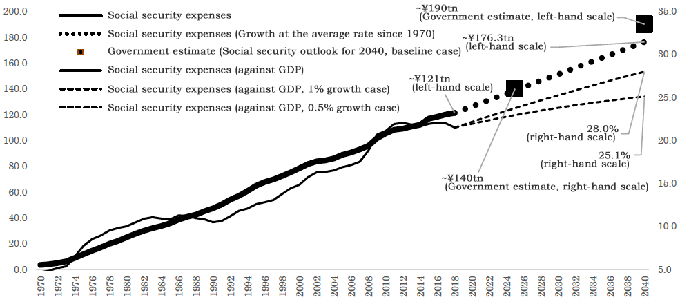2020 (the second year of the Reiwa era) has begun. The Tokyo Olympics will be held this summer, but drastic reform of social security is also important. The government has set up the "Multi-Generational Social Security Investigative Committee" as a command center for reform that will discuss the direction of institutional reforms that can provide peace of mind to all generations. While its mission was to summarize its final report by the summer of 2020, more involved reforms are required, including a course correction from the interim report.
"Future reexamination of social security looking to 2040 (Discussion material)," published by the government in May 2018, has become a reference for discussion of reform with a mid- to long-term perspective. However, as I maintained in my article of last year's Nihon Keizai Shimbun Keizai Kyoshitsu (November 6, 2019, morning edition), proceeding with reform discussions premised on these estimates carries a certain risk for the government.
Forecasting Social Security Payment Expenses (vs GDP) and Uncertainty Over Growth Rates
The reason for the risk is simple: there is uncertainty in future economic growth rates. For example, in the estimates published in the Discussion material mentioned above, the government estimates social security payment expenditure in two scenarios: a high-growth case and a low-growth case. Within these, in the low-growth baseline case, the most recent (FY2018) social security payment expenditures amounted to 121.3 trillion yen (21.5% of GDP), and are forecast to increase to 140 trillion yen by FY2025 (21.8% of GDP) and to around 190 trillion yen (24% of GDP) by FY2040.
Some say that the ratio to GDP will increase by just 2.5% (from 24% to 21.5%) by FY2040, and so there is no need to hurry reforms, but this perception is overoptimistic, because social security payment expenditures in FY2019 (on a budgetary basis) increased by 2.4 trillion yen against the previous year to 123.7 trillion yen, 22.1% of GDP, and the reality is that this is already higher than the forecast value for FY2025 (21.8%) (Note: FY2019 GDP is based on the July estimate issued by the Cabinet Office).

[Click to enlarge]
The solid bold line in the chart (left scale) shows trends in social security expenditures from FY1970 to FY2018; the rate of increase was about 2.5 trillion yen annually (equivalent to a 1% consumption tax rate). Growth over the past few years has been slower than 2.5 trillion yen, but assuming this rate continues, the bold dotted line in the chart shows the forecast for social security expenditures up to FY2040.
Based on this, FY2025 expenditures are about 138 trillion yen, which is close to the government estimate, and the FY2040 figure of 176.3 trillion yen is lower than the government estimate, but should the rate of growth decrease, the proportion of expenditures to GDP will increase. This is because there is uncertainty in the forecast growth rate used to calculate future nominal GDP, and even in the baseline case above, nominal GDP growth is expected to be 1.3% from FY2029. The 1.3% growth rate is assumed to be about three times the average growth rate between FY1995 and FY2018 (0.39%).
For this reason, by revising the assumed rate of growth from FY2019 onwards down to 0.5% and calculating the annual average increase in social security expenditure of 2.5 trillion yen (the bold dotted line in the chart) as a proportion of GDP, the 2040 value leaps to 28%. Indeed, assuming the rate of growth to be 1% and performing the same calculation, social security expenditure in FY2040 becomes 25.1% of GDP, which is close to the government estimate where the rate of growth is 1.3% (24%). However, a decrease in the economic growth rate of 0.3 percentage points is enough to cause the ratio of expenditures to GDP to jump by 1 percentage point.
Reform in the Face of Reality
A 1% increase in the consumption tax rate will raise tax revenues by about 0.5% against GDP, and expenditures (against GDP) are to increase by 6.5 percentage points (=28% - 21.5%) between FY2018 and FY2040. Even excluding reductions in the current budget deficit, it will be necessary to find resources equivalent to a consumption tax increase of around 13%.
On the other hand, in the government's economic assessment, the longest post-war economic expansion has been ongoing since December 2012, but tax revenues for 2019 (the national general account budget) are increasingly expected to be significantly larger than the 62.5 trillion yen forecast in the 2019 initial budget as well as falling for the first time in 3 years. Given the context of the Tokyo Olympics, it is no surprise that the economic adjustment process is about to begin.
The "Integrated Social Security and Tax Reform" began in 2004 with pension reform and ended in October 2019 with the consumption tax rate being increased to 10%. Then, linked with the Supplementary Provisions of Article 104 of the "Act on Partial Revision of the Income Tax Act" (Act No.13 of 2009), although there was a change in government along the way, this process paved the way for a 2-stage increase in consumption tax to 10%. Reform did not end here, however. Integrated reform was nothing more than a temporary measure, and the situation surrounding the financial administration of Japan remains tough.
There is the possibility that the economic adjustment process may begin, and reforms in such situations are not easy. However, particularly now with the beginning of the new "Reiwa" era, both we and the government must face reality, and advance the rebuilding of social security (fundamental reform of the balance of benefits and burdens), such as through the introduction of a medical macroeconomic slide (Note 1), toward "Integrated Social Security and Tax Reform Version 2.0." I hope that 2020 will become a turning point that enables authentic transformation into a system that will be compatible with an aging society and a shrinking population.


